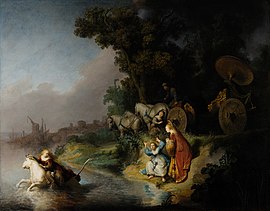
In Greek mythology, Europa was a Phoenician princess from Tyre, Lebanon and the mother of King Minos of Crete. The continent of Europe is named after her. The story of her abduction by Zeus in the form of a bull was a Cretan story; as classicist Károly Kerényi points out, "most of the love-stories concerning Zeus originated from more ancient tales describing his marriages with goddesses. This can especially be said of the story of Europa."

Jan Lievens was a Dutch Golden Age painter who was associated with his close contemporary Rembrandt, a year older, in the early parts of their careers. They shared a birthplace in Leiden, training with Pieter Lastman in Amsterdam, where they shared a studio for about five years until 1631. Like Rembrandt he painted both portraits and history paintings, but unlike him Lievens' career took him away from Amsterdam to London, Antwerp, The Hague and Berlin.

Rembrandt Harmenszoon van Rijn, usually simply known as Rembrandt, was a Dutch Golden Age painter, printmaker, and draughtsman. An innovative and prolific master in three media, he is generally considered one of the greatest visual artists in the history of art. It is estimated Rembrandt produced a total of about three hundred paintings, three hundred etchings, and two thousand drawings.
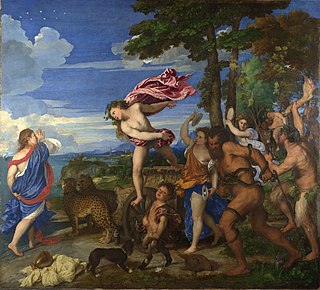
Bacchus and Ariadne (1522–1523) is an oil painting by Titian. It is one of a cycle of paintings on mythological subjects produced for Alfonso I d'Este, Duke of Ferrara, for the Camerino d'Alabastro – a private room in his palazzo in Ferrara decorated with paintings based on classical texts. An advance payment was given to Raphael, who originally held the commission for the subject of a Triumph of Bacchus.

Joachim Anthoniszoon Wtewael was a Dutch Mannerist painter and draughtsman, as well as a highly successful flax merchant, and town councillor of Utrecht. Wtewael was one of the leading Dutch exponents of Northern Mannerism, and his distinctive and attractive style remained largely untouched by the naturalistic developments happening around him, "characterized by masterfully drawn, highly polished figures often set in capricious poses". Wtewael was trained in the style of late 16th-century Haarlem Mannerism and remained essentially faithful to it, despite painting well into the early period of Dutch Golden Age painting.
The Rape of Persephone, or Abduction of Persephone, is a classical mythological subject in Western art, depicting the abduction of Persephone by Hades. In this context, the word Rape refers to the traditional translation of the Latin raptus which refers to bride kidnapping rather than the potential ensuing sexual violence.

Jacques Specx was a Dutch merchant, who founded the trade on Japan and Korea in 1609. Jacques Specx received the support of William Adams to obtain extensive trading rights from Tokugawa Ieyasu, the shōgun emeritus, on 24 August 1609, which allowed him to establish a trading factory in Hirado on 20 September 1609. He was the interim governor in Batavia between 1629 and 1632. There his daughter Saartje Specx was involved in a scandal. Back home in Holland Specx became an art-collector.

Andromeda Chained to the Rocks (1630) is a 34 cm × 24.5 cm oil-on-panel painting by the Dutch Golden Age painter Rembrandt. It is now in the Mauritshuis, The Hague, Netherlands. Andromeda represents Rembrandt's first full length mythological female nude history painting and is taken from a story in Ovid's Metamorphoses.

The Venetian painter Titian and his workshop made at least six versions of the same composition showing Danaë, painted between about 1544 and the 1560s. The scene is based on the mythological princess Danaë, as – very briefly – recounted by the Roman poet Ovid, and at greater length by Boccaccio. She was isolated in a bronze tower following a prophecy that her firstborn would eventually kill her father. Although aware of the consequences, Danaë was seduced and became pregnant by Zeus, who, inflamed by lust, descended from Mount Olympus to seduce her in the form of a shower of gold.
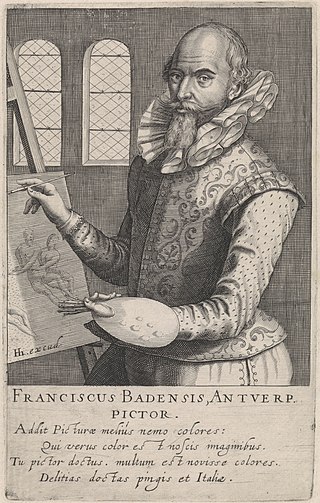
Frans Badens was a Flemish-born painter who was active in Amsterdam where he was known for his mythological and biblical scenes, genre scenes, portraits and still lifes. In his lifetime he was regarded as one of the most important painters who had moved to Amsterdam and was admired for his realistic treatment of the skin.

Het Schilder-Boeck or Schilderboek is a book written by the Flemish writer and painter Karel van Mander first published in 1604 in Haarlem in the Dutch Republic, where van Mander resided. The book is written in 17th-century Dutch and its title is commonly translated into English as 'The Book of Painters' or 'The Book of Painting' and sometimes as 'The Book on Picturing'. Het Schilder-Boeck consists of six parts and is considered one of the principal sources on the history of art and art theory in the 15th and 16th century Low Countries. The book was very well received and sold well. Karel van Mander died two years after its publication. A second posthumous edition, which included a brief, anonymous biography of van Mander was published in 1618. This second edition was translated by Hessel Miedema into English and published in 1994-1997 together with a facsimile of the original and five volumes of notes on the text.
Metamorphoses (Transformations) is a Latin narrative poem by the Roman poet Ovid, considered his magnum opus. Comprising fifteen books and over 250 myths, the poem chronicles the history of the world from its creation to the deification of Julius Caesar within a loose mythico-historical framework. Although meeting the criteria for an epic, the poem defies simple genre classification by its use of varying themes and tones.
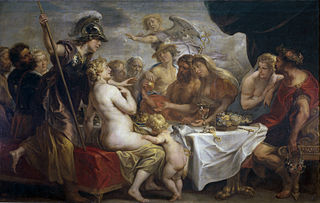
The Feast of the Gods or Banquet of the Gods as a subject in art showing a group of deities at table has a long history going back into antiquity. Showing Greco-Roman deities, it enjoyed a revival in popularity in the Italian Renaissance, and then in the Low Countries during the 16th century, when it was popular with Northern Mannerist painters, at least partly as an opportunity to show copious amounts of nudity.

Mercury and Argus is an oil painting on canvas executed ca. 1620 by the Flemish painter Jacob Jordaens. It is in the collection of the Museum of Fine Arts of Lyon. It is the first of many versions that Jordaens painted of Ovid's rendering of the mythological story of the murder by Mercury of the giant Argus. Some of the other versions depict other scenes of the story.
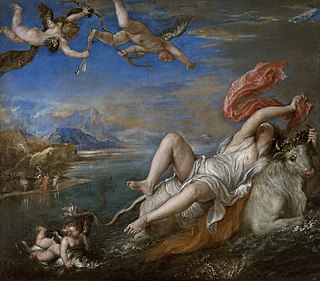
The Rape of Europa is a painting by the Venetian artist Titian, painted ca. 1560–1562. It is in the permanent collection of the Isabella Stewart Gardner Museum of Boston, Massachusetts. The oil-on-canvas painting measures 178 by 205 centimetres.

The Rape of Ganymede is an oil painting of 1635 by the Dutch Golden Age painter Rembrandt, depicting the myth of Ganymede. It is in the collection of the Gemäldegalerie Alte Meister in Dresden.
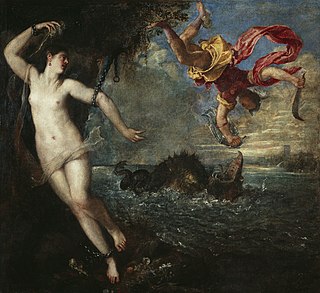
Perseus and Andromeda is a painting by the Italian Renaissance artist Titian, now in the Wallace Collection in London. It was painted in 1554–1556 as part of a series of mythological paintings called "poesie" ("poetry") intended for King Philip II of Spain. The paintings took subjects from the Roman poet Ovid's Metamorphoses, in this case Book IV, lines 663–752, and all featured female nudes.

The Pardo Venus is a painting by the Venetian artist Titian, completed in 1551 and now in the Louvre Museum. It is also known as Jupiter and Antiope, since it seems to show the story of Jupiter and Antiope from Book VI of the Metamorphoses. It is Titian's largest mythological painting, and was the first major mythological painting produced by the artist for Philip II of Spain. It was long kept in the Royal Palace of El Pardo near Madrid, hence its usual name; whether Venus is actually represented is uncertain. It later belonged to the English and French royal collections.

In 1635, Peter Paul Rubens created Venus and Adonis, now in the Metropolitan Museum of Art, New York. He followed the mythological story in the Metamorphoses by Ovid, inspired from his love of classical literature and earlier depictions of this scene. This oil on canvas painting shows Venus accompanied by Cupid, embracing and pulling Adonis before he goes off to hunt. The artist uses specific colors, detail and strong contrast between light and dark to depict a dramatic and emotional scene. At the time Rubens created the painting, the mythological story of Venus and Adonis was popular in Renaissance and Baroque court art. Rubens was clearly inspired by the many existing depictions of this scene, in particular the famous Titian composition of the same name, of which there are numerous versions. This depicts the same moment of Adonis leaving Venus to hunt, despite her pleas to stay. He is killed later in the day.
